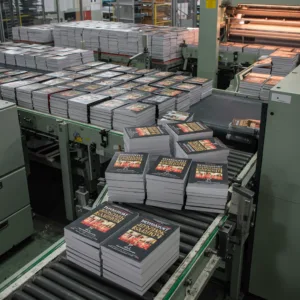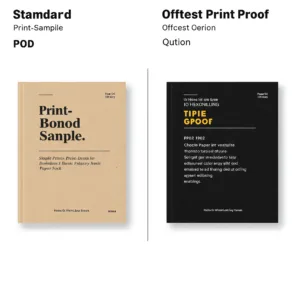Ready to bring your book to life without the hefty price tag of domestic printing? Printing in China offers a cost-effective solution with high-quality results, but navigating the process and understanding the timelines can feel daunting. That’s where we come in!
Printing a book in China typically takes 8-10 weeks. This includes:
- 4-5 weeks for printing and binding (for standard books)
- 4-5 weeks for shipping (depending on your location and shipping method)
Factors that can affect the timeline include book specifications (size, page count, color), printing quantity, paper type, binding style, and any additional services you require (proofreading, design, etc.).
Printing in China can be faster and more affordable than you think! We break down the entire process, from finding the right printer to managing costs and timelines, so you can confidently bring your book to life.
Key takeaways:
- Understand the factors that influence printing time in China.
- Learn how to estimate a realistic timeline for your book project.
- Discover cost-saving strategies and find the right printing partner.
- Get expert insights and step-by-step guidance for navigating the process.
Factors Affecting Printing Time in China

Table 1: Printing Timeline Overview
| Sub-Heading | Details |
|---|---|
| Total Printing Time | 8-10 weeks |
| Printing and Binding | 4-5 weeks |
| Shipping | 4-5 weeks |
| Factors Affecting Time | Book specs, quantity, paper type, binding, additional services |
Several factors influence the time it takes to print your book in China. Understanding these can help you plan and manage your expectations effectively.
Book Specifications
The specifications of your book play a significant role in determining the printing time.
- Trim size: Larger books naturally take longer to print.
- Page count: A 500-page tome will take longer than a 100-page novella.
- Hardcover vs. paperback: Hardcover books involve more complex binding processes, adding to the production time.
- Color vs. black and white: Full-color printing requires more intricate setups and drying times compared to black and white.
For example, a 500-page hardcover art book with full-color printing will naturally have a longer production time than a 200-page black and white paperback novel.
Printing Quantity
While you might think larger print runs would take significantly longer, economies of scale come into play. Printing 1,000 books may take a certain number of days on the press, while 5,000 books could take only slightly longer due to efficient press setup and production processes.
Paper Type and Availability

The type of paper you choose can also affect the timeline. Standard paper is readily available, while specialty paper (like textured or recycled options) might need to be sourced or imported, which can add time.
Printing and Binding Methods

Different printing and binding methods have varying time implications. Offset printing is generally faster for larger quantities, while digital printing is more efficient for smaller runs. Similarly, different binding styles like perfect bound, saddle stitch, or case binding have different production times.
And when it comes to the quality of the final product, Richard Nash, a respected figure in the publishing industry, notes that ‘The quality of book printing in China is often higher than in the US or Europe. Chinese printers have invested heavily in state-of-the-art equipment, and their attention to detail is remarkable.’ So, you can expect top-notch results when printing in China.”
You can learn more about the different types of binding in our detailed guide: 10 Types of Book Binding You Should Know About (With Examples).
Shipping and Logistics

Shipping your books from China involves several steps, including:
- Freight: Sea freight is more cost-effective but takes longer (4-5 weeks to the US), while air freight is faster but more expensive.
- Customs clearance: This can add a few days to the timeline.
- Potential delays: Unforeseen circumstances like port congestion or weather can cause delays.
Additional Services
If you require additional services like proofreading, design, or ISBN registration, these will add to the overall timeline. It’s essential to factor in these extra steps when planning your project.
For insights into the importance of professional book editing and its role in the publishing process, check out this helpful article
Estimating Printing Time: A Realistic Timeline
To give you a clearer picture, let’s break down the typical printing process in China and provide estimated timelines for each stage:
-
Pre-press (file preparation, proofing): This stage involves preparing your files for printing and reviewing proofs. If you need to go through multiple rounds of revisions, it can take around 4 weeks.
-
Printing and binding: For standard books with common specifications, the actual printing and binding process usually takes about 4-5 weeks.
-
Shipping: The shipping time depends on your location and the chosen shipping method. As mentioned earlier, sea freight from China to the US typically takes 4-5 weeks.
You can find more details about shipping books from China in our comprehensive guide: Ship Books from China: The Ultimate Guide (2025).
Tips for Managing Time Expectations
- Plan ahead: Starting the process early allows ample time for each stage and accommodates potential delays.
- Communicate clearly: Establish clear deadlines and expectations with your printer from the outset.
- Streamline the process: Use project management tools or checklists to stay organized and track progress.
- Be proactive: Follow up regularly with your printer and address any issues promptly.
Printing Costs in China: A Breakdown
Table 2: Cost Components and Influences
| Sub-Heading | Details |
|---|---|
| Cost Components | |
| Printing Fees | Setup, labor, machine usage |
| Paper Costs | Type, quality, quantity |
| Binding Costs | Style-dependent |
| Shipping Costs | Method and location |
| Import Duties | Country-dependent |
| Factors Influencing Costs | |
| Book Specifications | Larger, complex books |
| Printing Quantity | Economies of scale |
| Paper Choice | Specialty vs. standard |
| Printing Technology | Offset vs. digital |
| Shipping Method | Air vs. sea |
One of the most appealing aspects of printing in China is the potential for significant cost savings. Let’s break down the cost components and explore strategies to maximize your budget.
Cost Components
When printing books in China, you’ll typically encounter the following costs:
- Printing fees: These cover the actual printing process, including setup, labor, and machine usage.
- Paper costs: The cost of paper varies depending on the type, quality, and quantity you choose.
- Binding costs: Different binding styles have different costs associated with them.
- Shipping costs: As discussed earlier, shipping costs vary depending on the method (sea or air freight) and your location.
- Import duties: Depending on your country, you may have to pay import duties on your books.
Factors Influencing Costs
Several factors can influence the overall cost of printing in China:
- Book specifications: Larger, more complex books with special features will naturally cost more.
- Printing quantity: Generally, the higher the print run, the lower the cost per book due to economies of scale.
- Paper choice: Specialty papers and higher-quality paper stock will increase the cost.
- Printing technology: Offset printing is usually more cost-effective for larger quantities, while digital printing is better for smaller runs. You can learn more about the differences between offset and digital printing in our article: Offset vs Digital Printing: Which Is Right for YOU?
- Shipping method: Air freight is faster but more expensive than sea freight.
Cost-Saving Strategies
Here are some strategies to help you save on printing costs:
- Optimize book design: Efficient page layout and design choices can reduce the overall page count and paper usage.
- Choose cost-effective paper: Consider using standard paper options if they meet your needs. You can explore different paper types in our article: What Are the Different Types of Paper for Book Printing?
- Consider bulk printing: Printing in larger quantities can significantly reduce the cost per book.
- Explore different shipping options: Compare sea and air freight options to find the most cost-effective solution for your needs.
Data and Statistics
To give you a better idea of potential savings, consider these statistics:
- Printing in China can be 30-50% cheaper than in the US.
- The average cost per book in China can range from $1.50 to $5.00 for a 1,000-copy paperback novel, $3.00 to $8.00 for a 500-copy hardcover children’s book, and $10.00 to $20.00 for a 1,000-copy full-color art book, depending on specifications and printing choices.
This aligns with the experience of bestselling author and self-publishing expert Joanna Penn, who states that ‘China offers the most competitive printing prices globally, especially for larger print runs. Even factoring in shipping, it can be significantly cheaper than printing domestically.’
So, not only can you achieve high-quality printing, but you can also significantly reduce your expenses by choosing to print in China.”
Finding the Right Printing Partner in China
With so many printing companies in China, finding the right partner for your book project is crucial. Here’s how to navigate the selection process:
Resources for Finding Printers
- Directly Contacting Printing Companies: Many printing companies have their own websites with contact information and online forms. You can use Google to search for “[type of book] printing China” and find potential printers to contact directly.
- Online directories: Websites like Alibaba and Global Sources list numerous Chinese printing companies.
- Industry associations: Organizations like the Printing and Printing Equipment Industries Association of China (PEIAC) can provide referrals.
- Referrals: Ask other authors or publishers for recommendations based on their experiences.
Save time and money on your next book printing project. Get a free consultation from Mainland Printing and discover the advantages of printing in China.
Evaluating Potential Printers
Once you have a list of potential printers, evaluate them based on these key factors:
- Experience: Look for printers with a proven track record in book printing, especially for your specific book type (e.g., hardcover, children’s books).
- Certifications: Check for relevant certifications like ISO 9001 (quality management) or FSC (responsible forestry).
- Client testimonials: Read reviews and testimonials from previous clients to gauge their satisfaction.
- Sample books: Request sample books to assess the printer’s quality and craftsmanship.
- Communication and customer service: Ensure the printer has good communication skills and is responsive to your inquiries.
Navigating the Printing Process: A Step-by-Step Guide
Now that you’ve found a printing partner, let’s walk through the printing process step-by-step:
1. File Preparation
Proper file preparation is essential for a smooth printing process. Here’s what you need to know:
- File formats: Most printers prefer PDF files for printing. Ensure your files are in the correct format and meet the printer’s specifications.
- Image resolution: Use high-resolution images (300 dpi or higher) for sharp and clear printing.
- Bleed: Include bleed in your design (extending the artwork slightly beyond the trim edge) to avoid white margins after trimming. You can learn more about bleed in our article: What Is Bleed in Printing and Why Does It Matter?
- Color mode: Use CMYK color mode for accurate color reproduction.
- Fonts: Embed all fonts in your PDF file or convert them to outlines to avoid font issues during printing.
2. Requesting Quotes and Comparing Printers
When requesting quotes from printers, be sure to provide detailed specifications about your book, including:
- Trim size
- Page count
- Binding style
- Paper type
- Printing quantity
Compare quotes from different printers, paying attention to:
- Pricing
- Production time
- Shipping costs
- Minimum order quantity
- Customer service
3. Communication and Project Management
Effective communication is key throughout the printing process. Here are some tips:
- Set clear expectations: Discuss your project requirements, deadlines, and budget with your printer upfront.
- Use online collaboration tools: Platforms like Google Drive or Dropbox can facilitate file sharing and communication.
- Address language barriers: If needed, use translation tools or work with a printing agent who can assist with communication.
4. Production and Quality Control
Once your files are approved, the printer will start production. Here’s what to expect:
- Proofing: The printer will typically provide digital proofs or hard copy proofs for your final approval before printing the full quantity.
- Printing: The books will be printed using the chosen printing technology (offset or digital).
- Binding: The printed pages will be bound according to your chosen binding style.
- Quality control: The printer will conduct quality checks throughout the production process to ensure your books meet the required standards. You can learn more about quality control in book printing in our comprehensive guide: Quality Control in Book Printing: A Comprehensive Guide.
5. Shipping and Delivery
Once the books are printed and bound, they will be shipped to your designated location. Here’s what you need to know:
- Freight forwarders: You may need to work with a freight forwarder to handle shipping logistics and customs clearance.
- Import/export regulations: Be aware of any import/export regulations that may apply to your shipment.
- Tracking: Obtain a tracking number to monitor your shipment’s progress.
For a helpful overview of international shipping and freight forwarding, visit agi.global.
Case Studies
Case Study 1: The Fantasy Author Who Found Success Overseas
Take the example of Sarah Miller, a self-published fantasy author who was struggling to keep printing costs down for her debut novel, ‘The Shadow of Skyreach.’ Quotes from local printers were eating into her potential profits, making it difficult to invest in marketing and promotion.
Then, she discovered the option of printing in China. By partnering with a reputable Chinese printing company, Sarah was able to reduce her printing costs by 40% while still achieving the high-quality printing she desired. This allowed her to allocate more of her budget to marketing efforts, such as targeted Facebook ads and book blogger outreach.
The result? ‘The Shadow of Skyreach’ became a bestseller, exceeding Sarah’s initial sales goals and launching her successful career as an independent author.
Case Study 2: The Photographer’s Stunning Coffee Table Book
Another compelling example is the experience of landscape photographer, David Chen. He had always dreamed of publishing a stunning coffee table book showcasing his breathtaking panoramic photographs of the American Southwest. However, the cost of printing a large-format, hardcover book with high-quality paper and unique layflat binding in the US was astronomical.
Determined to bring his vision to life, David explored printing options in China. He found a printing company specializing in art books and was impressed by their expertise and attention to detail. The final product was a masterpiece—a beautifully printed and bound book that captured the grandeur of David’s photographs.
Printing in China not only made his dream a reality but also allowed him to offer the book at a more accessible price point, increasing its reach and impact.
Conclusion
Printing your book in China can be a strategic move, offering significant cost savings and access to high-quality printing capabilities. However, it requires careful planning, communication, and the selection of a reliable printing partner.
By understanding the factors that influence printing time, managing your expectations, and following the step-by-step guide outlined in this article, you can navigate the process with confidence. Remember to:
- Start early and plan ahead.
- Communicate clearly with your printer.
- Choose a reputable printing partner.
- Optimize your book design for cost-efficiency.
- Conduct thorough quality checks.
If you’re ready to explore printing your book in China, we encourage you to request quotes from different printers, compare their offerings, and embark on your printing journey.
Resources and Further Reading
To further assist you in your book printing journey, we’ve compiled a list of helpful resources:
- Glossary of Printing Terms
- Paper Selection Guide
- Shipping Calculator
- How Much Does It Cost to Print a Book in 2025?
- Hardcover vs Softcover Books: Which Should YOU Choose?
- Offset vs Digital Printing: Which Is Right for YOU?







